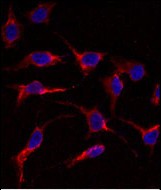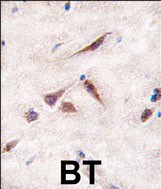ERAS Antibody (N-term)
Purified Rabbit Polyclonal Antibody (Pab)
- SPECIFICATION
- CITATIONS: 3
- PROTOCOLS
- BACKGROUND

Application
| FC, IF, IHC-P, WB, E |
|---|---|
| Primary Accession | Q7Z444 |
| Reactivity | Human |
| Host | Rabbit |
| Clonality | Polyclonal |
| Isotype | Rabbit IgG |
| Calculated MW | 25287 Da |
| Antigen Region | 13-42 aa |
| Gene ID | 3266 |
|---|---|
| Other Names | GTPase ERas, E-Ras, Embryonic stem cell-expressed Ras, ERAS, HRAS2, HRASP |
| Target/Specificity | This ERAS antibody is generated from rabbits immunized with a KLH conjugated synthetic peptide between 13-42 amino acids from the N-terminal region of human ERAS. |
| Dilution | FC~~1:10~50 IF~~1:10~50 IHC-P~~1:50 WB~~1:1000 E~~Use at an assay dependent concentration. |
| Format | Purified polyclonal antibody supplied in PBS with 0.09% (W/V) sodium azide. This antibody is prepared by Saturated Ammonium Sulfate (SAS) precipitation followed by dialysis against PBS. |
| Storage | Maintain refrigerated at 2-8°C for up to 2 weeks. For long term storage store at -20°C in small aliquots to prevent freeze-thaw cycles. |
| Precautions | ERAS Antibody (N-term) is for research use only and not for use in diagnostic or therapeutic procedures. |
| Name | ERAS |
|---|---|
| Synonyms | HRAS2, HRASP |
| Function | Ras proteins bind GDP/GTP and possess intrinsic GTPase activity. Plays an important role in the tumor-like growth properties of embryonic stem cells (By similarity). |
| Cellular Location | Cell membrane; Lipid-anchor; Cytoplasmic side |

Provided below are standard protocols that you may find useful for product applications.
Background
Ras proteins bind GDP/GTP and possess intrinsic GTPase activity. Point mutations of several amino acids of human RAS, including gly12, ala59, or glu63, render the protein constitutively active. Embryonic stem cell-expressed Ras (ERAS) has serine, alanine, and asparagine at the positions corresponding to gly12, ala59, and glu63 of human RAS, suggesting that it is constitutively active.The PI3K (phosphoinositide 3-kinase) pathway is important for proliferation, survival and maintenance of pluripotency in ES cells. The PI3K pathway is activated by growth factors and cytokines including insulin and leukaemia inhibitory factor. In addition to these exogenous factors, the PI3K pathway is endogenously activated by the constitutively active Ras family protein ERas (ES cell-expressed Ras). ERas null ES cells maintained pluripotency but show significantly reduced growth and tumorigenicity, which can be rescued by expression of ERas cDNA or by activated phosphatidylinositol 3-hydroxykinase. The transforming oncogene ERAS appears to be important in the tumor-like growth properties of ES cells.
References
Kameda,T., Stem Cells 23 (10), 1535-1540 (2005)
Takahashi,K., Nature 423 (6939), 541-545 (2003)
Miyoshi,J., Nucleic Acids Res. 12 (4), 1821-1828 (1984)
If you have used an Abcepta product and would like to share how it has performed, please click on the "Submit Review" button and provide the requested information. Our staff will examine and post your review and contact you if needed.
If you have any additional inquiries please email technical services at tech@abcepta.com.














 Foundational characteristics of cancer include proliferation, angiogenesis, migration, evasion of apoptosis, and cellular immortality. Find key markers for these cellular processes and antibodies to detect them.
Foundational characteristics of cancer include proliferation, angiogenesis, migration, evasion of apoptosis, and cellular immortality. Find key markers for these cellular processes and antibodies to detect them. The SUMOplot™ Analysis Program predicts and scores sumoylation sites in your protein. SUMOylation is a post-translational modification involved in various cellular processes, such as nuclear-cytosolic transport, transcriptional regulation, apoptosis, protein stability, response to stress, and progression through the cell cycle.
The SUMOplot™ Analysis Program predicts and scores sumoylation sites in your protein. SUMOylation is a post-translational modification involved in various cellular processes, such as nuclear-cytosolic transport, transcriptional regulation, apoptosis, protein stability, response to stress, and progression through the cell cycle. The Autophagy Receptor Motif Plotter predicts and scores autophagy receptor binding sites in your protein. Identifying proteins connected to this pathway is critical to understanding the role of autophagy in physiological as well as pathological processes such as development, differentiation, neurodegenerative diseases, stress, infection, and cancer.
The Autophagy Receptor Motif Plotter predicts and scores autophagy receptor binding sites in your protein. Identifying proteins connected to this pathway is critical to understanding the role of autophagy in physiological as well as pathological processes such as development, differentiation, neurodegenerative diseases, stress, infection, and cancer.




